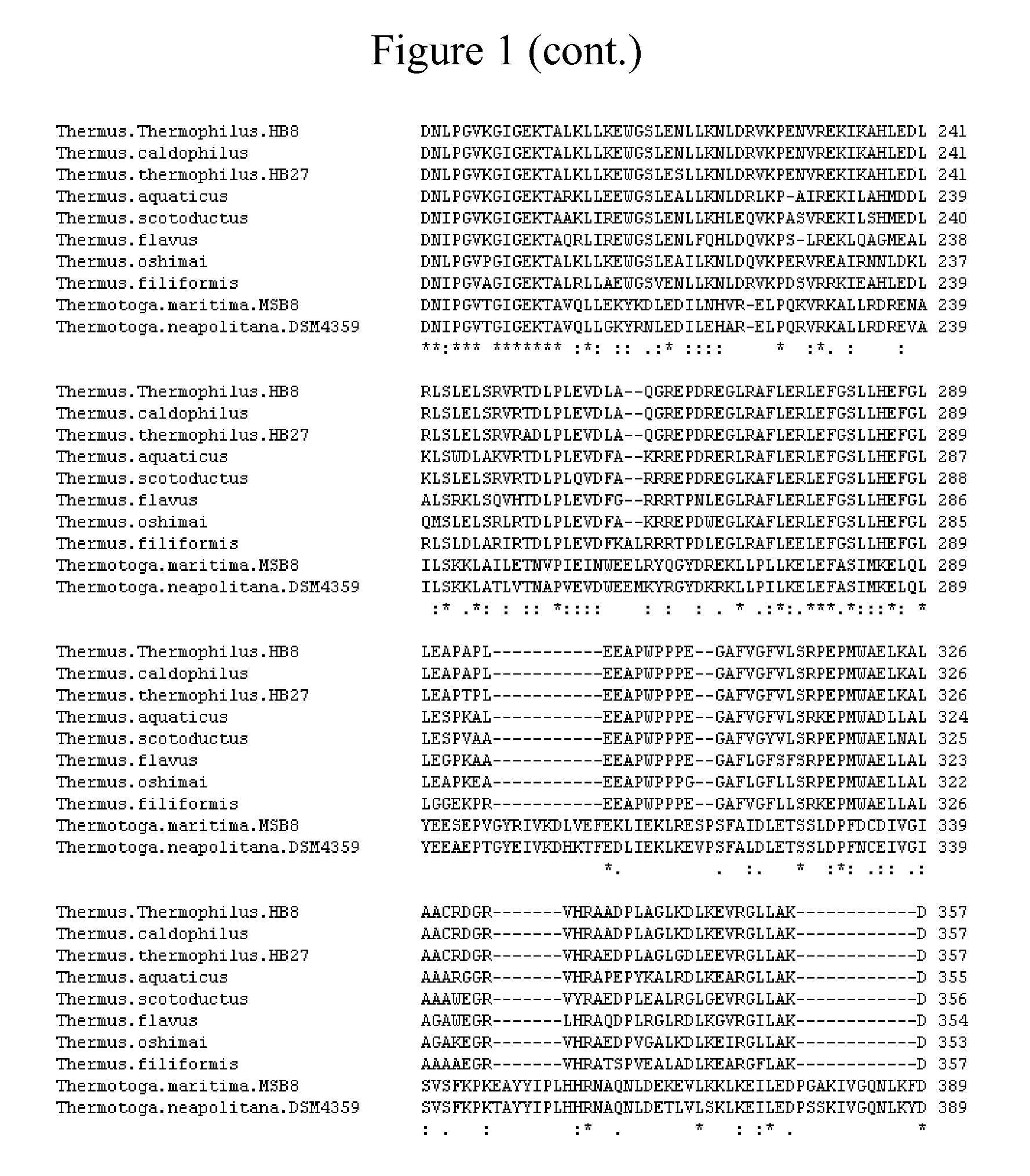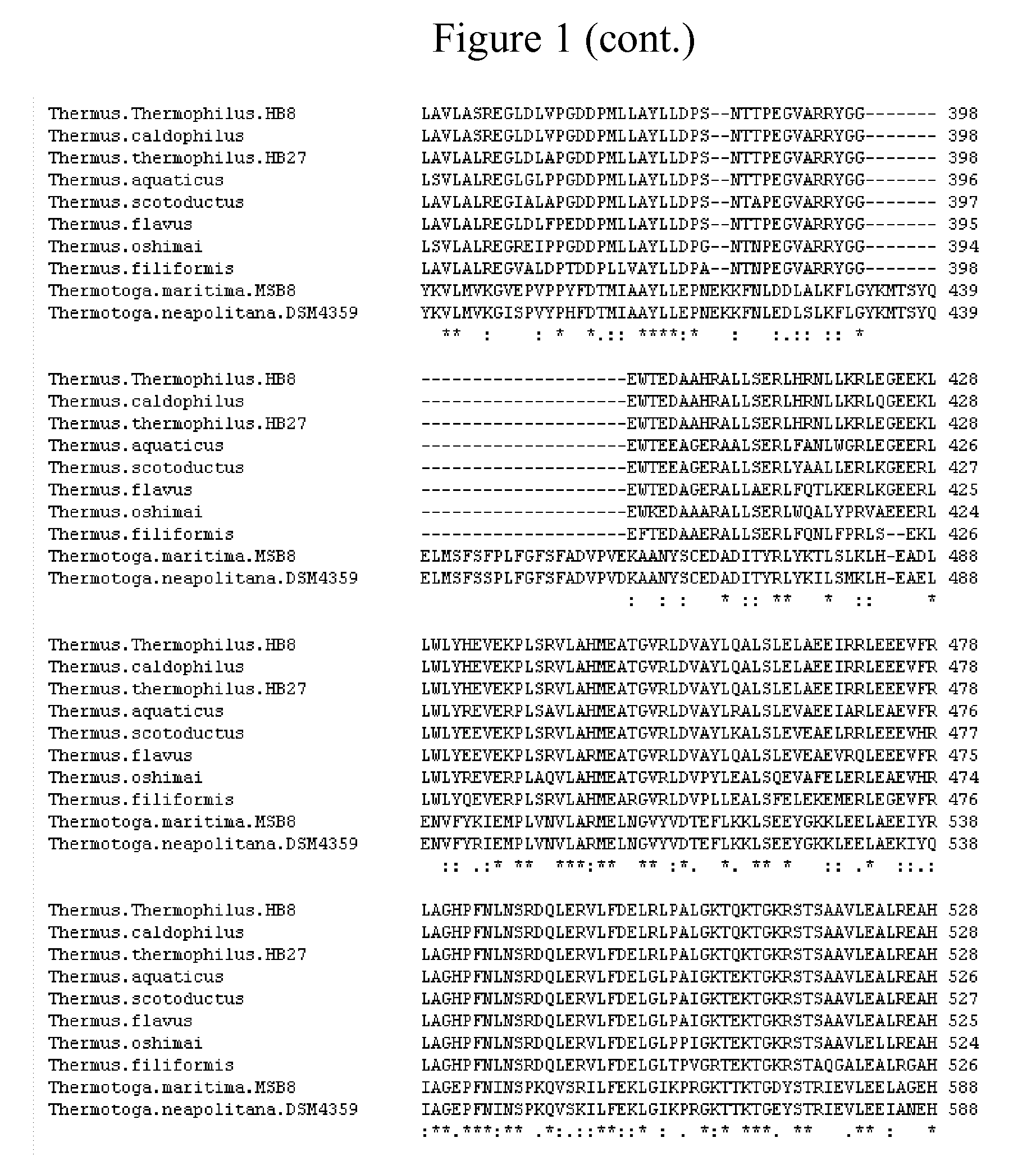Thermostable type-a DNA polymerase mutants with increased polymerization rate and resistance to inhibitors
a dna polymerase and mutant technology, applied in the field of molecular biology, can solve the problems of few mutant dna polymerases suitable for use, reaction reports, and loss of precious nucleic acids from samples, and achieve the effect of amplifying target nucleic acids more rapidly
- Summary
- Abstract
- Description
- Claims
- Application Information
AI Technical Summary
Benefits of technology
Problems solved by technology
Method used
Image
Examples
example 1
Generation and Screening of Mutant Polymerases
[0080]Mutant Taq DNA polymerases were generated by random mutagenesis of a nucleic acid comprising the sequence of SEQ ID NO:4, which encoded wild-type Taq DNA polymerase (SEQ ID NO:11). Briefly, random mutant libraries were subject to 5 rounds of selection under fast cycling conditions, followed by screening (after rounds 2, 4, and 5) to identify clones that support amplification using shortened extension times. Polymerases showing improved performance during Real-Time PCR under fast cycling conditions, as compared to wild-type Taq DNA polymerase, were subjected to DNA sequencing to identify mutations. Mutations of interest appearing in fast-amplifying clones were identified and recombined using site-directed mutagenesis. Recombinants were screened using Real-Time PCR with fast cycling conditions. Mutant polymerases that outperformed both wild-type Taq and the best performers from the original selection / screening were identified, sequen...
example 2
Mutant Polymerases Amplify better than Wild-Type Taq Under Fast Cycling Conditions
[0081]Selected mutant polymerases obtained according to Example 1 were further characterized to assess their ability to polymerize a nucleic acid chain from a primer. Specifically, real-time quantitative PCR reactions were performed under “fast cycling” conditions to amplify a 69 base-pair target nucleic acid.
[0082]Real-time PCR reactions using SYBR® Green dye to monitor amplification of the template were performed using wild-type Taq DNA polymerase and a mutant according to the invention referred to as “2C2” (SEQ ID NO:38). Two different real-time PCR systems were used: the Step-One-Plus™ system from Applied Biosystems (Life Technologies) and the SmartCycler® system (Cepheid). Extension times for the amplification reactions were varied in the experiment to generate data for a variety of time points, in order to better characterize the difference between the mutant and wild-type enzymes. As shown in FI...
example 3
Further Characterization of Mutant Polymerase Performance Under Fast Cycling Conditions
[0084]In this Example 3, Real-Time PCR was performed on a 160 base-pair target DNA molecule, SYBR® Green, and the PCR systems of Example 2. The results are shown in FIG. 3, Panels A-C.
[0085]FIG. 3, Panel A, shows Real-Time QPCR amplification plots comparing amplification of the 160 base-pair template using a 5 second denaturation period at 95° C., and a 60 second extension period at 60° C. (total cycling time of 66 minutes), and a Step-One-Plus™ PCR system. As can be seen from the panel, the mutant according to the present invention showed an earlier Ct compared to the wild-type enzyme. Panel B shows amplification plots for amplifications run using a 5 second denaturation period at 95° C., and a 15 second extension period at 60° C. (total cycling time of 25 minutes), using the SmartCycler™ system. Under these conditions, the difference between the mutant and wild-type enzymes is even more pronounc...
PUM
| Property | Measurement | Unit |
|---|---|---|
| Fraction | aaaaa | aaaaa |
| Fraction | aaaaa | aaaaa |
| Fraction | aaaaa | aaaaa |
Abstract
Description
Claims
Application Information
 Login to View More
Login to View More - R&D
- Intellectual Property
- Life Sciences
- Materials
- Tech Scout
- Unparalleled Data Quality
- Higher Quality Content
- 60% Fewer Hallucinations
Browse by: Latest US Patents, China's latest patents, Technical Efficacy Thesaurus, Application Domain, Technology Topic, Popular Technical Reports.
© 2025 PatSnap. All rights reserved.Legal|Privacy policy|Modern Slavery Act Transparency Statement|Sitemap|About US| Contact US: help@patsnap.com



